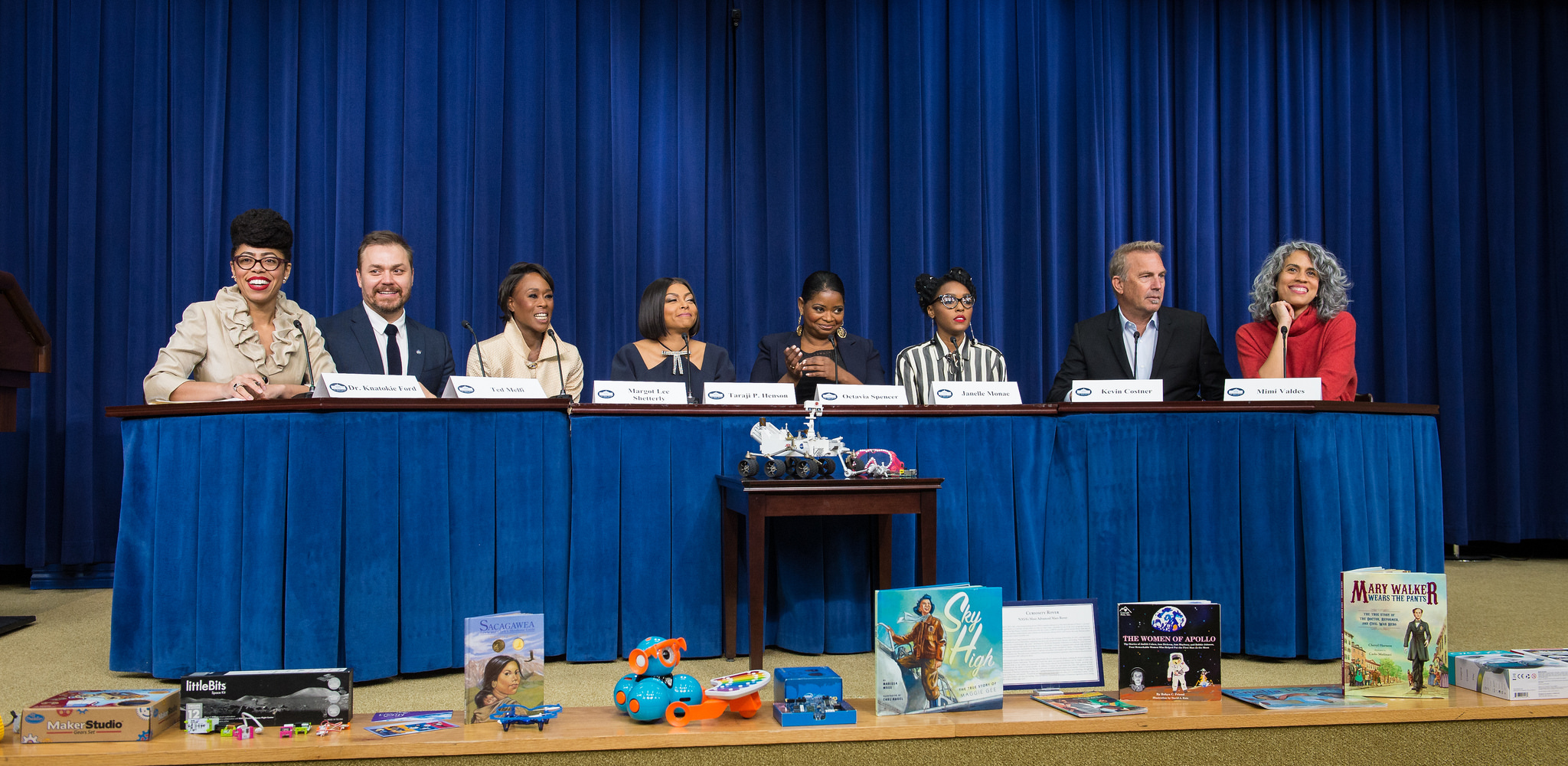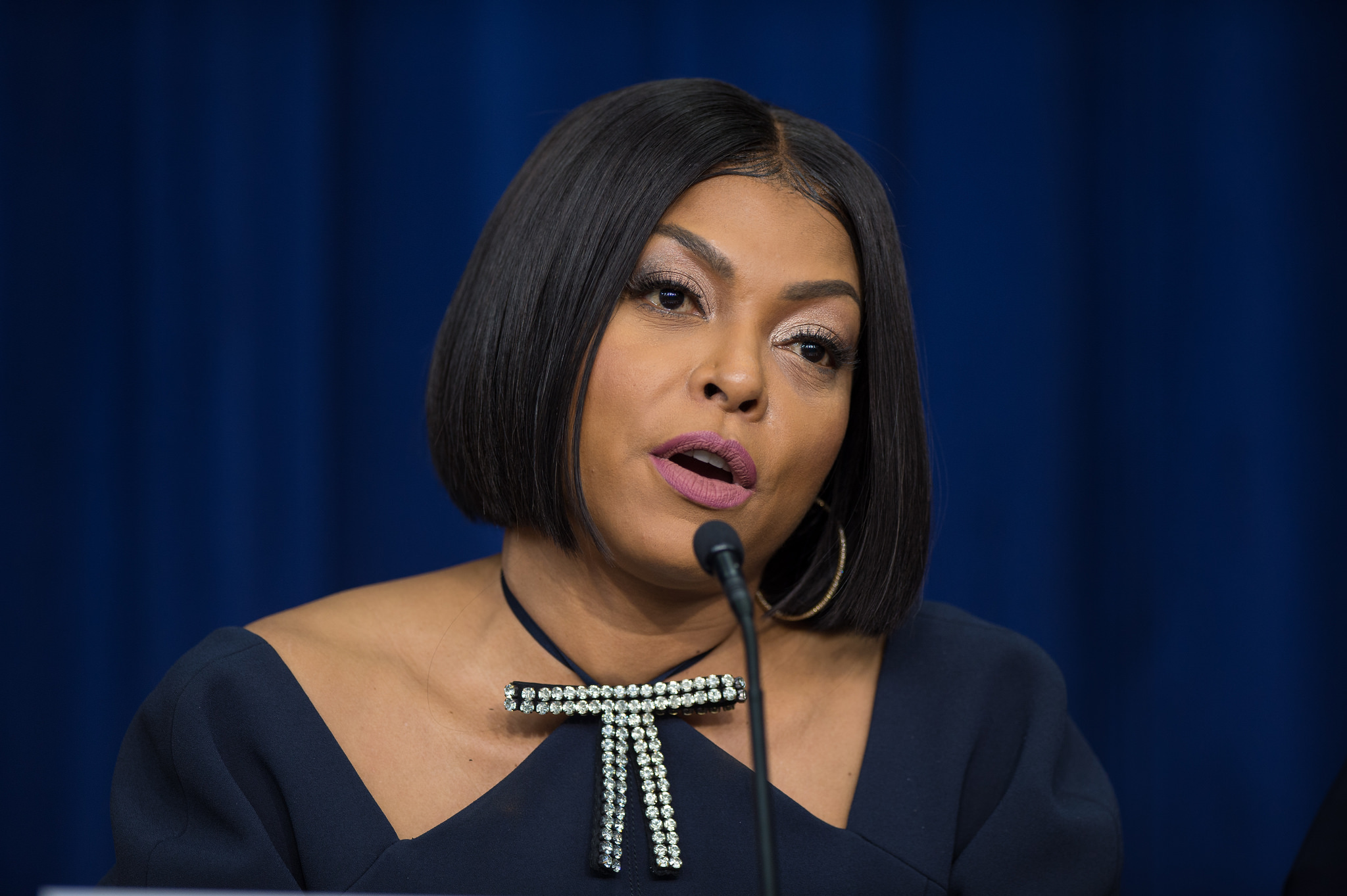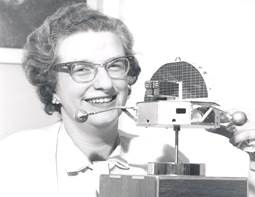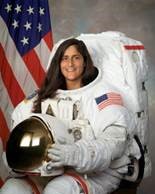

Talented women and men have long worked together to accomplish the greatest human achievements. And yet, some individuals who have played critical roles in these achievements, notably women and people of color, are under-represented in the retelling of these stories. Unconscious bias and the tendency toward stereotyping often result in an inaccurate picture of teamwork, collaboration, and contributions. Most significantly, it limits future innovation.
Over the past two years the President has awarded the Presidential Medal of Freedom to pioneering technical women in space and computing: Katherine Johnson (Mercury, Gemini, Apollo, Shuttle, exploration missions), Margaret Hamilton (Apollo, Skylab), and Navy Rear Admiral Grace Hopper (the “Queen of Code”). Leaders in the advertising industry are also working to correct biased depictions of women with their #SeeHer program launched during the United State of Women event in June 2016.
Hollywood too has begun correcting a long-standing impact of unconscious bias. Writers, directors, producers, and actors are beginning to surface untold stories and include characters previously left out. They are beginning to demand and create more accurate depictions of STEM depictions of STEM (science, technology, engineering, and mathematics) endeavors and the people who engage in them. As actress Geena Davis has said, “If she can see it, she can be it.”
Last week, as part of a series of events that celebrated untold stories of women in STEM and Computer Science Education Week, the First Lady welcomed to the White House some of the cast and team behind the new film Hidden Figures. The White House Office of Science and Technology Policy also hosted a panel of notable technical and scientific women from NASA who have shaped the world and contributed to NASA's exploration of worlds formerly beyond reach.

Watch the Hidden Figures team panel and the remarks from First Lady Michelle Obama (YouTube) -->
 NASA)
NASA)

View all NASA photos from the event (Flickr) -->
Check out NASA’s Modern Figures Website and Educational Toolkit (share @NASA #ModernFigures) -->
The stories shared at last week’s White House event are those of contributors to extraordinary teams. Here are some of those women leaders who worked during four eras of space exploration:
Era 1: Pre-Sputnik (--1957)
Katharine and Susan Koerner Wright (Wright Family), Bessie Coleman, Grace Hopper, Hedy Lamar, the ENIAC Programmers, Amelia Earhart, Maggie Gee and Ola Mildred Rexroat of the Women Airforce Service Pilots (WASPs), and many more.
Era 2: First Launch-Mercury-Gemini-Apollo (1957-1970s)
Mary Sherman Morgan, Dorothy Vaughn, Katharine Johnson, Wally Funk, Jeanne Crews, Geraldyn (“Jerrie”) M. Cobb, Dorothy “Dottie” Lee, Margaret Hamilton, and many more.
Era 3: Shuttle – Hubble - Space Station (1970s-1990s)
Nancy Roman, Shannon Lucid, Mae Jemison, Margaret Rhea Seddon, Kathryn Sullivan, Peggy Whitson, Yvonne Cagle, and many more.
Era 4: Now (1990s-)
Dava Newman, Marleen Martinez Sundgaard, Eileen Collins, Adriana Ocampo, Gwynn Shotwell, Debbie Martinez, Sunita Williams, Ellen Ochoa, Julie Kramer White, and many more.
Here are some ways that you can help to improve the accuracy of history and share more stories about the incredible women in STEM:
- Participate in edit-a-thons and team-up with others to host one! (we held our first at the White House STEM Heroes Edit-a-thon during African-American History Month in 2015).
- Host short-film festivals on campus, in your classroom, in your organization, or at home (White House Office of Science Technology Policy hosted“ STEM on the Silver Screen” at the White House in 2014 and the National Archives hosted their 2106 McGowan Forum with short films and a conversation on “Women in Leadership: From the Computer Age to the Digital Age”).
- Share stories of STEM and other heroes on social media using the hashtags #MissingHistory, #HiddenFigures, and #GalaxyofWomen.
- Remember to include all of the key players when telling stories about STEM achievements.
Please share your thoughts on diversity in STEM and tell the story of others who are missing figures from well-known history. Tweet with #STEMforAll and @WhiteHouseOSTP to let others know.
Megan Smith (@USCTO) is the U.S. Chief Technology Officer
Jo Handelsman (@Jo44) is Associate Director for Science at the White House Office of Science and Technology Policy
Knatokie Ford is a Senior Policy Advisor at the White House Office of Science and Technology Policy
Join us: Read about some of the amazing women and their teams who have advanced human understanding of the universe. Find others and share them.
Era 1: Pre-Sputnik (--1957)
Bessie Coleman was born on January 26, 1892, in Atlanta, Texas. She was the tenth of thirteen children. Her father was part Cherokee and her mother was African-American. She had to walk four miles each day to her segregated, one-room school where she loved to read and was an outstanding math student. She was working as a manicurist at the White Sox Barber Shop where she heard stories from pilots returning home from World War I about flying during the war. She took a second job at a chili parlor to procure money faster to become a pilot. As American flight schools admitted neither women nor blacks, she traveled to Paris to obtain her pilot’s license. On June 15, 1921, she became the first female pilot of African American descent and was also the first woman of Native American descent to hold a pilot license and to hold an international pilot license. She became a media sensation when she returned to the United States, becoming known as stunt flier “Queen Bess” and performing daredevil maneuvers for paying audiences. Tragically, she was killed during a rehearsal for an aerial show at age 34.
Wright Family: Susan Catherine Koerner Wright, mother of Wilbur and Orville Wright, spent considerable time in her youth designing and building mechanical appliances; she guided her children whenever she could and always encouraged them to chase their curiosities. Katharine Wright was born in Dayton, Ohio on August 19, 1874 and spent time working with her brothers.
Hedy Lamarr was an Austrian and American film actress and inventor born on November 9, 1914. Although better known for her Silver Screen exploits, Hedy Lamarr (born Hedwig Eva Maria Kiesler) also became a pioneer in the field of wireless communications following her emigration to the United States. The international beauty icon, along with co-inventor George Anthiel, developed a "Secret Communications System" to help combat the Nazis in World War II. By manipulating radio frequencies at irregular intervals between transmission and reception, the invention formed an unbreakable code to prevent classified messages from being intercepted by enemy personnel. In 1997, Lamarr became the first female recipient of the BULBIE™ Gnass Spirit of Achievement Award, a prestigious lifetime accomplishment prize for inventors that is dubbed "The Oscar™ of Inventing."
Rear Admiral Dr. Grace Hopper was born in New York City on December 9, 1906. In 1928, she earned a BA in mathematics and physics from Vassar College, and an MA and a PhD in mathematics from Yale in 1930 and 1934, respectively. She taught at Vassar as an associate professor until 1943, when she joined the United States Naval Reserve to assist her country in its wartime challenges. During her academic, industry, and military tenure, Admiral Hopper's numerous talents were apparent. A true visionary, Admiral Hopper conceptualized how a much wider audience could use the computer if there were tools that were both programmer-friendly and application-friendly. Hopper invented the first compiler for a computer programming language. She popularized the idea of machine-independent programming languages, which led to the development of COBOL, one of the first high-level programming languages. In 2016, Hopper was posthumously honored with the Presidential Medal of Freedom by President Obama.

Era 2: First Launch-Mercury-Gemini-Apollo (1957-1970s)
Geraldyn ("Jerrie") M. Cobb was born on March 5, 1931 in Norman, Oklahoma. She earned her private pilot’s license at the age of 17 while still a student at Oklahoma City Classen High School. A year later, she would add a commercial pilot’s license to her name. Cobb was also a part of the “Mercury 13” – the first women astronaut trainees – who underwent rigorous physical and mental testing in preparation for space flight, until the program was canceled by NASA.
Katherine Johnson was born in White Sulphur Springs, West Virginia on August 26, 1918. At the age of 15, she began attending West Virginia State College, eventually taking every math course the college offered. Several professors took Johnson under their wings, including W.W. Schiefflin Claytor, the third African American to receive a PhD in math in the United States. Johnson went on to become an integral mathematician at NASA, calculating, by hand, the trajectory for Alan Shepard, the first American to fly into space on May 5, 1961. Even after NASA began using electronic computers, John Glenn requested that she personally recheck the calculations made by the new electronic computers before his flight aboard Friendship 7 – the mission on which he became the first American to orbit the Earth. She continued to work at NASA until 1986, combining her math talent with electronic computer skills. Her calculations proved critical to the success of the Apollo Moon landing program and the country’s journey into space.
Dorothy Vaughan was an American mathematician who worked at the National Advisory Committee for Aeronautics (NACA), which was the predecessor agency to NASA. First a high school math teacher, she later began working at Langley Memorial Aeronautical Laboratory in 1943 in electronic computing. In 1951, she became the head of the West Area Computers, a group composed entirely of black, female mathematicians, including notable members like Katherine Johnson.
Mary Sherman Morgan was born on November 4, 1921 in Ray, North Dakota. In the early 1950s, Morgan was the only female analyst among 900 rocket scientists at North American Aviation. She was also one of the few without a college degree. She is credited with the invention of the liquid fuel Hydyne in 1957, which powered the Jupiter-C rocket that boosted the United States' first satellite, Explorer 1.
Wally Funk was born on February 1, 1939 in Las Vegas, New Mexico. In 1961, she volunteered for the “Women in Space” Program, becoming one of the “Mercury 13” – the first women astronaut trainees. Funk, like the other participants in the program, was put through rigorous physical and mental testing. Despite passing her tests and qualifying for space travel, the program was canceled before the women were to undergo their last test.
Dorothy “Dottie” Lee was a mathematician for NACA’s Langley Aeronautical Laboratory. As a project engineer, she was responsible for design, trajectory, and stability analysis of spacecraft. While NACA became NASA, she continued her work predicting the performance of the Apollo heat shield. The Orion capsule that is being built today uses an Apollo style heat shield based on predictions she calculated.
Jeanne Crews is an American engineer and one of the first female engineers to work at Johnson Space Center. At JSC, she worked as an aeronautical engineer in the Flight Crew Support Division, Experiments Systems Division, and Solar System Exploration Division. As an engineer, one of the largest problems she tackled was space debris, creating a multishock shield to protect vehicles and astronauts. She later took a management role in the Space and Life Sciences Directorate. She has been decorated with medals from both JSC and NASA Headquarters.
Margaret Hamilton was born in Paoli, Indiana on August 17, 1936. She played a critical role in the development of the flight software for NASA’s Apollo program. As a computer scientist leading the Software Engineering Division of the MIT Instrumentation Laboratory, she helped develop the Apollo program’s guidance system. For her work during this period, Hamilton has been credited with creating and popularizing the concept of software engineering. In 2016, Hamilton was honored with the Presidential Medal of Freedom by President Barack Obama.

Era 3: Shuttle-Hubble-Space Station (1970s-1990s)
Nancy Roman was born in Nashville, Tennessee on May 16, 1925. When she was 11 years old, she formed an astronomy club with her classmates to read books about constellations once a week. She pursued her passion for astronomy in college, and received a PhD in Astronomy from the University of Chicago. She went on to become the Chief of Astronomy at NASA, the only woman with an executive position. She was central to setting up the Hubble Space Telescope, which was launched into orbit in 1990 and remains in operation today. She is known to many as “Mother of Hubble”. She also has an asteroid named after her - “2516 Roman”.
Shannon Lucid was born in 1943 in China, where her parents were Baptist missionaries. She grew up in Oklahoma and received her Bachelors, her Masters, and PhD in Biochemistry from the University of Oklahoma. She was part of the first class of NASA astronauts that included women. She flew on several spaceflights, including one aboard Mir that lasted 188 days, a record at the time. She performed numerous life science and physical science experiments during the mission.
Mae Jemison was born in Decatur, Alabama on October 17, 1956. As young girl, Jemison expressed a passion for science. She graduated from Chicago's Morgan Park High School in 1973 and entered Stanford University at the age of 16, graduating in 1977 with a Bachelor’s of Science degree in chemical engineering and Bachelor’s of Arts in African & Afro-American Studies. Upon graduation, she entered Cornell University Medical College. After medical school and a brief general practice, Jemison served in the Peace Corps from 1985 until 1987, when she was selected by NASA to join the astronaut corps, becoming the first African-American woman to be admitted into the astronaut training program.
Margaret Rhea Seddon was born in Tennessee in 1947. She completed medical school and surgery residency, and became an Emergency Department surgeon. She was selected by NASA to become an astronaut in 1978, the first class of astronauts to include women. She flew on three Space Shuttle flights and conducted several medical experiments in space. She has been active in medicine following her career in NASA, and published her first book “Go For Orbit” in 2015.
Era 4: Now (1990s-)
Sunita Williams was born in Euclid, Ohio in 1965 and has Indian and Slovenian ancestry. She attended the United States Naval Academy and received a Master of Science degree in Engineering Management from Florida Institute of Technology. She became a United States Navy Officer and was selected to become an astronaut in 1998. She holds the record for total spacewalks by a woman (seven) and most spacewalk time for a woman (50 hours, 40 minutes). She has carried the Hindu holy book Bhagavad Gita during space flights. On April 16, 2007, she became the first person to run a marathon in space. She is now slated to be one of the first astronauts on U.S. commercial spaceflights.
Kathryn Sullivan was born in 1951 in New Jersey. She received a Bachelors degree in Earth Sciences and a PhD in Geology, working in Alaska as an oceanographer. A crew member on three NASA Space Shuttle missions, she is the first American woman to walk in space. She was appointed by President Barack Obama to serve as the Under Secretary of Commerce for Oceans and Atmosphere and Administrator of the National Oceanic and Atmospheric Administration (NOAA).
Peggy Whitson was born in 1960 and grew up on a farm in rural Iowa. She majored in biology and chemistry in college, and then earned a PhD in biochemistry. She worked for many years as a scientist at NASA, and was selected in 1996 as a candidate to become an astronaut. She became NASA's most experienced female astronaut, with over 376 days in space. On November 17, 2016, she launched into space and arrived at the International Space Station for another mission. She is now the oldest woman to fly into space at age 56. By the end of this scheduled mission, she will have spent more time in space than any other American astronaut.
Yvonne Cagle was born in 1959 in West Point, New York. She trained to become a medical doctor, completing her bachelor's degree in biochemistry from San Francisco State University and a doctor of medicine degree from the University of Washington. She received certification as a senior aviation medical examiner from the Federal Aviation Administration in 1995. She became a member of the Astronaut Class of 1996. Currently, she is currently assigned to Johnson Space Center's Space and Life Sciences Directorate. She is also an advisor for NASA's Flight Opportunities Program. She has recently been selected reserve crew for Hawai‘i Space Exploration Analog and Simulation (HI-SEAS), which is part of a study for NASA to determine the best way to keep astronauts well-nourished during multiple-year missions to Mars or the moon.
Jaime Waydo grew up in Bozeman, Montana. She earned her Bachelor's degree in Mechanical Engineering from Montana State University in 2000, and completed her Master's degree in Mechanical and Aerospace Engineering at UCLA in 2006. She led the rover mobility mechanical team for the Mars Science Laboratory mission at NASA's Jet Propulsion Laboratory in Pasadena, CA. She is now a leader in the self-driving car program at Alphabet.
Dava Newman is Professor of Aeronautics and Astronautics and Engineering Systems at the Massachusetts Institute of Technology. She is best known for promoting the development of the Bio-Suit, which is designed to help astronauts move around more easily than gas-filled suits allow. She was appointed Deputy Administrator of NASA by President Barack Obama.
Marleen (Martinez) Sundgaard, a child of migrant farm workers, knew from the age of five that she wanted to be an astronaut. She studied Aeronautical & Astronautical Engineering at the University of Washington, earning her bachelors of science degree in 2006. After graduation she began working at Lockheed Martin Space Systems Company working as a test engineer on various satellite projects as well as working on the Orion Multi-Purpose Crew Vehicle. She is now a Systems Engineer at NASA Jet Propulsion Laboratory.
Eileen Collins was born in Elmira, New York in 1956. She became a pilot in the US Air Force after graduating from Syracuse University, and was selected to be an astronaut in 1990. She became the first female pilot and first female commander of a Space Shuttle. A testament to her skilled piloting, she became the first astronaut to perform a complete 360-degree pitch maneuver of the space shuttle as it rendezvoused with the International Space Station prior to docking.
Adriana Ocampo was born in Colombia and was raised in Argentina. She was interested in space from a young age. She moved to the United States as a teenager and immediately asked: “Where is NASA?” She received her Bachelors and Masters of Science Degrees while working full-time as a research assistant at NASA’s Jet Propulsion Laboratory (JPL) in California. As the Science Program Manager at NASA Headquarters, she was in charge of missions to study planets – Jupiter, Venus, Pluto. Her research led to the discovery of the Chicxulub impact crater, which is responsible for killing dinosaurs and 50% of life on our planet.
Gwynne Shotwell was born in Illinois in 1963. She received, with honors, a Bachelor of Science and a Master of Science in Mechanical Engineering and Applied Mathematics from Northwestern University. She authored dozens of papers on a variety of subjects, including standardizing spacecraft/payload interfaces, conceptualizing small spacecraft design, infrared signature target modeling, space shuttle integration, and reentry vehicle operational risks. She joined SpaceX in 2002 as Vice President of business development and is now President and Chief Operating Officer of the company.
Dr. Ellen Ochoa is an engineer, former astronaut, and the current Director of Johnson Space Center. She is the first Hispanic woman to go to space. Her first mission was aboard the shuttle Discovery in 1993. Before she became an astronaut, she developed spacecraft technology at NASA’s Ames Research Center. In space, she logged nearly 1,000 hours over the course of four flights.
Julie Kramer White received her Bachelor of Science in Aeronautical and Astronautical Engineering degree from Purdue, and her Master of Science in Mechanical Engineering degree at the University of Utah. An engineer with NASA since the late 80s/early 90s, White was trained by the “crusty old-school Apollo guys” and was often the only woman around. She’s now the Chief Engineer for the Orion Multi-Purpose Crew Vehicle. She is creating the next manned spacecraft to take people to an asteroid, the far side of the moon, and Mars moons.



